Investigating the Electromechanical Sensitivity of Carbon-Nanotube-Coated Microfibers
Abstract
1. Introduction
2. Materials and Methods
2.1. CNT Synthesis of Fiber Substrates
2.2. Electromechanical Compression
2.3. Simulation Details
3. Results
3.1. Electromechanical Experimental Results
3.2. Simulation Results
3.2.1. CNT Forest Morphology
3.2.2. Simulated Electromechanical Compression
4. Discussion
5. Conclusions
Supplementary Materials
Author Contributions
Funding
Data Availability Statement
Conflicts of Interest
References
- Boublil, B.L.; Diebold, C.A.; Moss, C.F. Mechanosensory Hairs and Hair-like Structures in the Animal Kingdom: Specializations and Shared Functions Serve to Inspire Technology Applications. Sensors 2021, 21, 6375. [Google Scholar] [CrossRef]
- Magal, C.; Dangles, O.; Caparroy, P.; Casas, J. Hair Canopy of Cricket Sensory System Tuned to Predator Signals. J. Theor. Biol. 2006, 241, 459–466. [Google Scholar] [CrossRef]
- Sterbing-D’Angelo, S.; Chadha, M.; Chiu, C.; Falk, B.; Xian, W.; Barcelo, J.; Zook, J.M.; Moss, C.F. Bat Wing Sensors Support Flight Control. Proc. Natl. Acad. Sci. USA 2011, 108, 11291–11296. [Google Scholar] [CrossRef]
- Zhang, C.; Zhang, J.; Chen, D.; Meng, X.; Liu, L.; Wang, K.; Jiao, Z.; Sun, T.; Wang, D.; Niu, S.; et al. Crack-Based and Hair-like Sensors Inspired from Arthropods: A Review. J. Bionic Eng. 2020, 17, 867–898. [Google Scholar] [CrossRef]
- Liu, C. Micromachined Biomimetic Artificial Haircell Sensors. Bioinspir. Biomim. 2007, 2, S162. [Google Scholar] [CrossRef]
- Tao, J.; Yu, X. Hair Flow Sensors: From Bio-Inspiration to Bio-Mimicking—A Review. Smart Mater. Struct. 2012, 21, 113001. [Google Scholar] [CrossRef]
- Shizhe, T. Underwater Artificial Lateral Line Flow Sensors. Microsyst. Technol. 2014, 20, 2123–2136. [Google Scholar] [CrossRef]
- Dagamseh, A. Reliability Investigation of Bioinspired Hair Flow-Sensor. IEEE Sens. J. 2021, 21, 22544–22552. [Google Scholar] [CrossRef]
- Wang, H.; Li, S.; Wang, Y.; Wang, H.; Shen, X.; Zhang, M.; Lu, H.; He, M.; Zhang, Y. Bioinspired Fluffy Fabric with In Situ Grown Carbon Nanotubes for Ultrasensitive Wearable Airflow Sensor. Adv. Mater. 2020, 32, 1908214. [Google Scholar] [CrossRef] [PubMed]
- Dagamseh, A.M.K.; Wiegerink, R.J.; Lammerink, T.S.J.; Krijnen, G.J.M. Towards a High-Resolution Flow Camera Using Artificial Hair Sensor Arrays for Flow Pattern Observations. Bioinspir. Biomim. 2012, 7, 046009. [Google Scholar] [CrossRef]
- Bian, Y.; Liu, R. Fabrication of a Biomimetic Piezoelectric Polyvinylidene Difluoride (PVDF) Fibre with a Metal Core and Its Application in Vibration Sensors. Trans. Inst. Meas. Control 2016, 40, 3–11. [Google Scholar] [CrossRef]
- Han, H.; Baik, S.; Xu, B.; Seo, J.; Lee, S.; Shin, S.; Lee, J.; Koo, J.H.; Mei, Y.; Pang, C.; et al. Bioinspired Geometry-Switchable Janus Nanofibers for Eye-Readable H2 Sensors. Adv. Funct. Mater. 2017, 27, 1701618. [Google Scholar] [CrossRef]
- Ko, H.; Song, H.; Im, S.; Kim, H.; Jang, B.; Shim, H. Bioinspired Piezoresistive Acceleration Sensor Using Artificial Filiform Sensillum Structure. Sens. Mater. 2015, 27, 437–445. [Google Scholar] [CrossRef]
- Abolpour Moshizi, S.; Moradi, H.; Wu, S.; Han, Z.J.; Razmjou, A.; Asadnia, M. Biomimetic Ultraflexible Piezoresistive Flow Sensor Based on Graphene Nanosheets and PVA Hydrogel. Adv. Mater. Technol. 2022, 7, 2100783. [Google Scholar] [CrossRef]
- Sengupta, D.; Trap, D.; Giri, A.; Kottapalli, P. Piezoresistive Carbon Nanofiber-Based Cilia-Inspired Flow Sensor. Nanomaterials 2020, 10, 211. [Google Scholar] [CrossRef]
- Kim, T.; Shin, H.-S.; Nam, K.-H.; Bergbreiter, S.; Park, Y.-L. Soft Airflow Sensors with Artificial Hair Structures and Printed Ionogel Channels for Wind Gust Detection for Small Uncrewed Vehicles. IEEE/ASME Trans. Mechatron. 2023, 1–11. [Google Scholar] [CrossRef]
- Alfadhel, A.; Li, B.; Zaher, A.; Yassine, O.; Kosel, J. A Magnetic Nanocomposite for Biomimetic Flow Sensing. Lab Chip 2014, 14, 4362–4369. [Google Scholar] [CrossRef]
- Becker, C.; Bao, B.; Karnaushenko, D.D.; Bandari, V.K.; Rivkin, B.; Li, Z.; Faghih, M.; Karnaushenko, D.; Schmidt, O.G. A New Dimension for Magnetosensitive E-Skins: Active Matrix Integrated Micro-Origami Sensor Arrays. Nat. Commun. 2022, 13, 2121. [Google Scholar] [CrossRef]
- Han, J.E.; Kim, D.; Yun, K.S. All-Polymer Hair Structure with Embedded Three-Dimensional Piezoresistive Force Sensors. Sens. Actuators A Phys. 2012, 188, 89–94. [Google Scholar] [CrossRef]
- Zhao, C.; Wang, Y.; Tang, G.; Ji, Y.; Zhao, X.; Mei, D.; Ru, J.; Chang, L.; Li, B.; Zhu, D.; et al. Biological Hair-Inspired AgNWs@Au-Embedded Nafion Electrodes with High Stability for Self-Powered Ionic Flexible Sensors. ACS Appl. Mater. Interfaces 2022, 14, 46023–46031. [Google Scholar] [CrossRef]
- Yin, B.; Liu, X.; Gao, H.; Fu, T.; Yao, J. Bioinspired and Bristled Microparticles for Ultrasensitive Pressure and Strain Sensors. Nat. Commun. 2018, 9, 5161. [Google Scholar] [CrossRef] [PubMed]
- Sugime, H.; Sato, T.; Nakagawa, R.; Hayashi, T.; Inoue, Y.; Noda, S. Ultra-Long Carbon Nanotube Forest via in Situ Supplements of Iron and Aluminum Vapor Sources. Carbon 2021, 172, 772–780. [Google Scholar] [CrossRef]
- Maschmann, M.R.; Zhang, Q.; Du, F.; Dai, L.; Baur, J. Length Dependent Foam-like Mechanical Response of Axially Indented Vertically Oriented Carbon Nanotube Arrays. Carbon 2011, 49, 386–397. [Google Scholar] [CrossRef]
- Maschmann, M.R.; Zhang, Q.; Wheeler, R.; Du, F.; Dai, L.; Baur, J. In Situ SEM Observation of Column-like and Foam-like CNT Array Nanoindentation. ACS Appl. Mater. Interfaces 2011, 3, 648–653. [Google Scholar] [CrossRef]
- Maschmann, M.R.; Ehlert, G.J.; Park, S.J.; Mollenhauer, D.; Maruyama, B.; Hart, A.J.; Baur, J.W. Visualizing Strain Evolution and Coordinated Buckling within CNT Arrays by in Situ Digital Image Correlation. Adv. Funct. Mater. 2012, 22, 4686–4695. [Google Scholar] [CrossRef]
- Maschmann, M.R.; Ehlert, G.J.; Tawfick, S.; Hart, A.J.; Baur, J.W. Continuum Analysis of Carbon Nanotube Array Buckling Enabled by Anisotropic Elastic Measurements and Modeling. Carbon 2014, 66, 377–386. [Google Scholar] [CrossRef]
- Cao, A.; Dickrell, P.L.; Sawyer, W.G.; Ghasemi-Nejhad, M.N.; Ajayan, P.M. Super-Compressible Foamlike Carbon Nanotube Films. Science 2005, 310, 1307–1313. [Google Scholar] [CrossRef]
- Suhr, J.; Victor, P.; Ci, L.; Sreekala, S.; Zhang, X.; Nalamasu, O.; Ajayan, P.M. Fatigue Resistance of Aligned Carbon Nanotube Arrays under Cyclic Compression. Nat. Nanotechnol. 2007, 2, 417–421. [Google Scholar] [CrossRef]
- Hutchens, S.B.; Hall, L.J.; Greer, J.R. In Situ Mechanical Testing Reveals Periodic Buckle Nucleation and Propagation in Carbon Nanotube Bundles. Adv. Funct. Mater. 2010, 20, 2338–2346. [Google Scholar] [CrossRef]
- Shahid Saeed Abadi, P.P.; Hutchens, S.B.; Greer, J.R.; Cola, B.A.; Graham, S. Effects of Morphology on the Micro-Compression Response of Carbon Nanotube Forests. Nanoscale 2012, 4, 3373–3380. [Google Scholar] [CrossRef]
- Pathak, S.; Lim, E.J.; Pour Shahid Saeed Abadi, P.; Graham, S.; Cola, B.A.; Greer, J.R. Higher Recovery and Better Energy Dissipation at Faster Strain Rates in Carbon Nanotube Bundles: An in-Situ Study. ACS Nano 2012, 6, 2189–2197. [Google Scholar] [CrossRef]
- Yaglioglu, O.; Cao, A.; Hart, A.J.; Martens, R.; Slocum, A.H. Wide Range Control of Microstructure and Mechanical Properties of Carbon Nanotube Forests: A Comparison between Fixed and Floating Catalyst CVD Techniques. Adv. Funct. Mater. 2012, 22, 5028–5037. [Google Scholar] [CrossRef]
- Zbib, A.A.; Mesarovic, S.D.; Lilleodden, E.T.; McClain, D.; Jiao, J.; Bahr, D.F. The Coordinated Buckling of Carbon Nanotube Turfs under Uniform Compression. Nanotechnology 2008, 19, 175704. [Google Scholar] [CrossRef] [PubMed]
- Pour Shahid Saeed Abadi, P.; Maschmann, M.R.; Baur, J.W.; Graham, S.; Cola, B.A. Deformation Response of Conformally Coated Carbon Nanotube Forests. Nanotechnology 2013, 24, 475707. [Google Scholar] [CrossRef] [PubMed]
- Brieland-Shoultz, A.; Tawfick, S.; Park, S.J.; Bedewy, M.; Maschmann, M.R.; Baur, J.W.; Hart, A.J. Scaling the Stiffness, Strength, and Toughness of Ceramic-Coated Nanotube Foams into the Structural Regime. Adv. Funct. Mater. 2014, 24, 5728–5735. [Google Scholar] [CrossRef]
- Tawfick, S.; Zhao, Z.; Maschmann, M.; Brieland-Shoultz, A.; De Volder, M.; Baur, J.W.J.W.; Lu, W.; Hart, A.J.J. Mechanics of Capillary Forming of Aligned Carbon Nanotube Assemblies. Langmuir 2013, 29, 5190–5198. [Google Scholar] [CrossRef] [PubMed]
- Pour Shahid Saeed Abadi, P.; Maschmann, M.R.; Mortuza, S.M.; Banerjee, S.; Baur, J.W.; Graham, S.; Cola, B.A. Reversible Tailoring of Mechanical Properties of Carbon Nanotube Forests by Immersing in Solvents. Carbon 2014, 69, 178–187. [Google Scholar] [CrossRef]
- Maschmann, M.R.; Ehlert, G.J.; Dickinson, B.T.; Phillips, D.M.; Ray, C.W.; Reich, G.W.; Baur, J.W. Bioinspired Carbon Nanotube Fuzzy Fiber Hair Sensor for Air-Flow Detection. Adv. Mater. 2014, 26, 3230–3234. [Google Scholar] [CrossRef]
- Park, M.; Cola, B.A.; Siegmund, T.; Xu, J.; Maschmann, M.R.; Fisher, T.S.; Kim, H. Effects of a Carbon Nanotube Layer on Electrical Contact Resistance between Copper Substrates. Nanotechnology 2006, 17, 2294. [Google Scholar] [CrossRef]
- Rego, K.; Meunier, V. Carbon Nanotube Knots. AIP Adv. 2019, 9, 025030. [Google Scholar] [CrossRef]
- George, S.M. Atomic Layer Deposition: An Overview. Chem. Rev. 2010, 110, 111–131. [Google Scholar] [CrossRef] [PubMed]
- Amama, P.B.; Pint, C.L.; Kim, S.M.; McJilton, L.; Eyink, K.G.; Stach, E.A.; Hauge, R.H.; Maruyama, B. Influence of Alumina Type on the Evolution and Activity of Alumina-Supported Fe Catalysts in Single-Walled Carbon Nanotube Carpet Growth. ACS Nano 2010, 4, 895–904. [Google Scholar] [CrossRef]
- Hajilounezhad, T.; Ajiboye, D.M.; Maschmann, M.R. Evaluating the Forces Generated during Carbon Nanotube Forest Growth and Self-Assembly. Materialia 2019, 7, 100371. [Google Scholar] [CrossRef]
- Brown, J.; Hajilounezhad, T.; Dee, N.; Kim, S.; Hart, A.J.; Maschmann, M. Delamination Mechanics of Carbon Nanotube Micropillars. ACS Appl. Mater. Interfaces 2019, 11, 35221–35227. [Google Scholar] [CrossRef] [PubMed]
- Maschmann, M.R. Integrated Simulation of Active Carbon Nanotube Forest Growth and Mechanical Compression. Carbon 2015, 86, 26–37. [Google Scholar] [CrossRef]
- Hajilounezhad, T.; Bao, R.; Palaniappan, K.; Bunyak, F.; Calyam, P.; Maschmann, M.R. Predicting Carbon Nanotube Forest Attributes and Mechanical Properties Using Simulated Images and Deep Learning. NPJ Comput. Mater. 2021, 7, 134. [Google Scholar] [CrossRef]
- Liu, Q.; Shi, X.; Jiang, Q.; Li, R.; Zhong, S.; Zhang, R. Growth Mechanism and Kinetics of Vertically Aligned Carbon Nanotube Arrays. EcoMat 2021, 3, e12118. [Google Scholar] [CrossRef]
- Pattinson, S.W.; Prehn, K.; Kinloch, I.A.; Eder, D.; Koziol, K.K.K.; Schulte, K.; Windle, A.H. The Life and Death of Carbon Nanotubes. RSC Adv. 2012, 2, 2909–2913. [Google Scholar] [CrossRef]
- Earp, B.; Dunn, D.; Phillips, J.; Agrawal, R.; Ansell, T.; Aceves, P.; De Rosa, I.; Xin, W.; Luhrs, C. Enhancement of Electrical Conductivity of Carbon Nanotube Sheets through Copper Addition Using Reduction Expansion Synthesis. Mater. Res. Bull. 2020, 131, 110969. [Google Scholar] [CrossRef]
- An, L.; Friedrich, C.R. Measurement of Contact Resistance of Multiwall Carbon Nanotubes by Electrical Contact Using a Focused Ion Beam. Nucl. Instrum. Methods Phys. Res. B 2012, 272, 169–172. [Google Scholar] [CrossRef]
- Jackson, R.; Graham, S. Specific Contact Resistance at Metal/Carbon Nanotube Interfaces. Appl. Phys. Lett. 2009, 94, 012109. [Google Scholar] [CrossRef]
- Israelachvili, J.N. Intermolecular and Surface Forces; Academic Press: Cambridge, MA, USA, 2011. [Google Scholar]
- Garcia, E.J.; Wardle, B.L.; John Hart, A.; Yamamoto, N. Fabrication and Multifunctional Properties of a Hybrid Laminate with Aligned Carbon Nanotubes Grown In Situ. Compos. Sci. Technol. 2008, 68, 2034–2041. [Google Scholar] [CrossRef]
- Mi, R.; Liu, H.; Wang, H.; Wong, K.W.; Mei, J.; Chen, Y.; Lau, W.M.; Yan, H. Effects of Nitrogen-Doped Carbon Nanotubes on the Discharge Performance of Li-Air Batteries. Carbon 2014, 67, 744–752. [Google Scholar] [CrossRef]
- Li, Y.J.; Ma, C.; Kang, J.L.; Shi, J.L.; Shi, Q.; Wu, D.H. Preparation of Diameter-Controlled Multi-Wall Carbon Nanotubes by an Improved Floating-Catalyst Chemical Vapor Deposition Method. New Carbon Mater. 2017, 32, 234–241. [Google Scholar] [CrossRef]
- Gaillard, J.; Skove, M.; Rao, A.M. Mechanical Properties of Chemical Vapor Deposition-Grown Multiwalled Carbon Nanotubes. Appl. Phys. Lett. 2005, 86, 233109. [Google Scholar] [CrossRef]
- Barreiro, A.; Selbmann, D.; Pichler, T.; Biedermann, K.; Gemming, T.; Rümmeli, M.H.; Schwalke, U.; Büchner, B. On the Effects of Solution and Reaction Parameters for the Aerosol-Assisted CVD Growth of Long Carbon Nanotubes. Appl. Phys. A Mater. Sci. Process. 2006, 82, 719–725. [Google Scholar] [CrossRef]
- Lim, Y.D.; Avramchuck, A.V.; Grapov, D.; Tan, C.W.; Tay, B.K.; Aditya, S.; Labunov, V. Enhanced Carbon Nanotubes Growth Using Nickel/Ferrocene-Hybridized Catalyst. ACS Omega 2017, 2, 6063–6071. [Google Scholar] [CrossRef]
- Cheng, J.; Zou, X.P.; Zhu, G.; Wang, M.F.; Su, Y.; Yang, G.Q.; Lü, X.M. Synthesis of Iron-Filled Carbon Nanotubes with a Great Excess of Ferrocene and Their Magnetic Properties. Solid. State Commun. 2009, 149, 1619–1622. [Google Scholar] [CrossRef]
- Fu, C.C.; Huang, H.Y.; Zhang, J.Y. One-Step Path to Highly Crystalline Multi-Walled Carbon Nanotubes with Large Inner Diameters. IOP Conf. Ser. Mater. Sci. Eng. 2019, 479, 012112. [Google Scholar] [CrossRef]
- Maschmann, M.R.; Dickinson, B.; Ehlert, G.J.; Baur, J.W. Force Sensitive Carbon Nanotube Arrays for Biologically Inspired Airflow Sensing. Smart Mater. Struct. 2012, 21, 094024. [Google Scholar] [CrossRef]

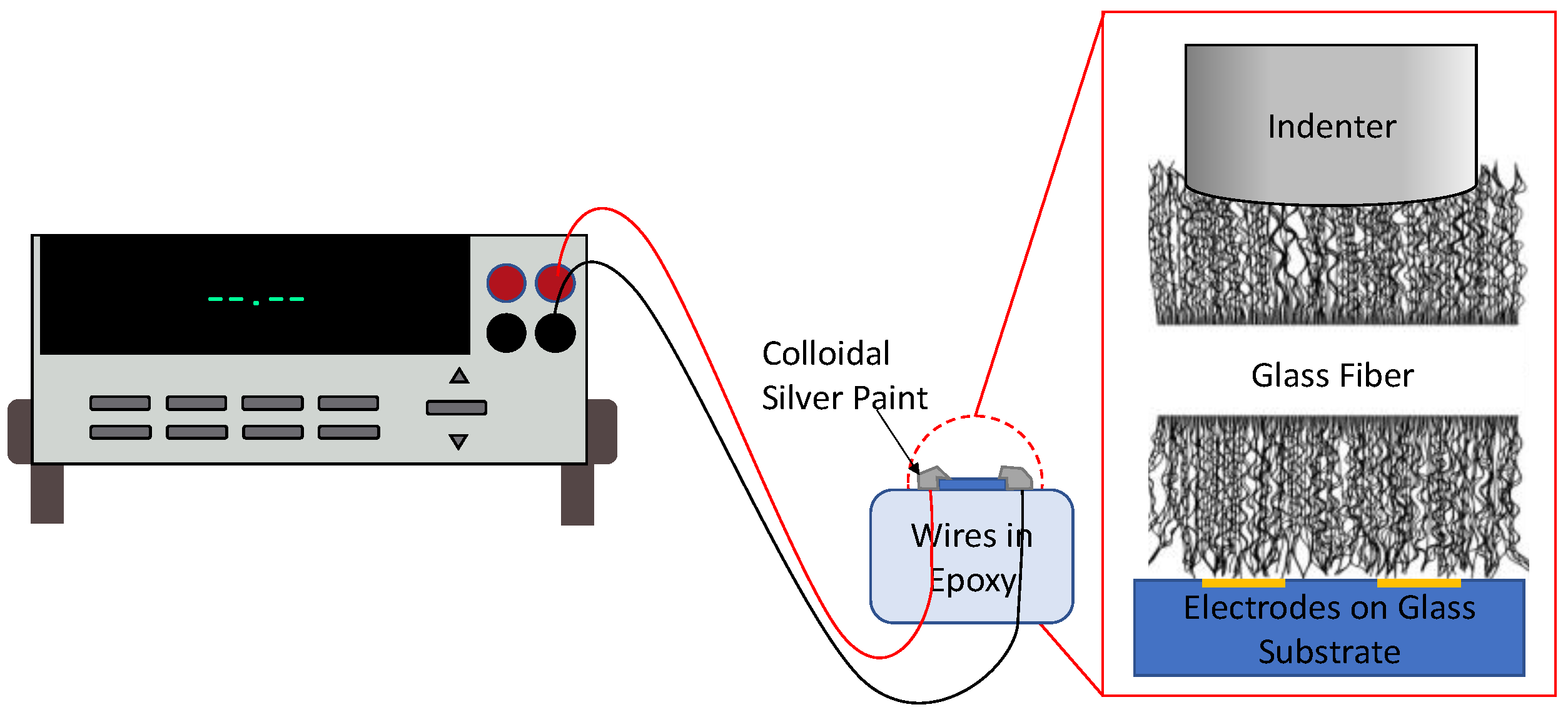


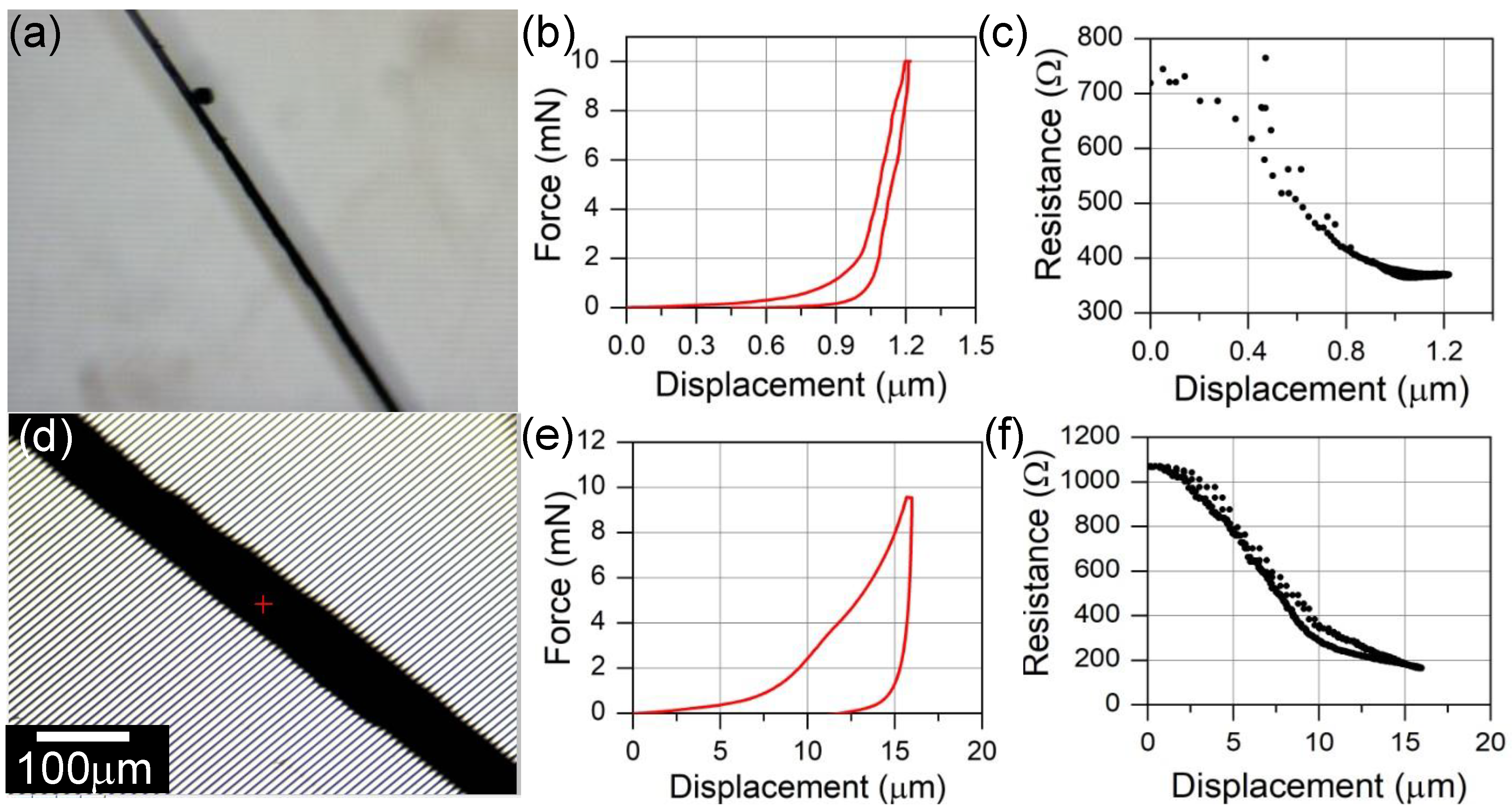


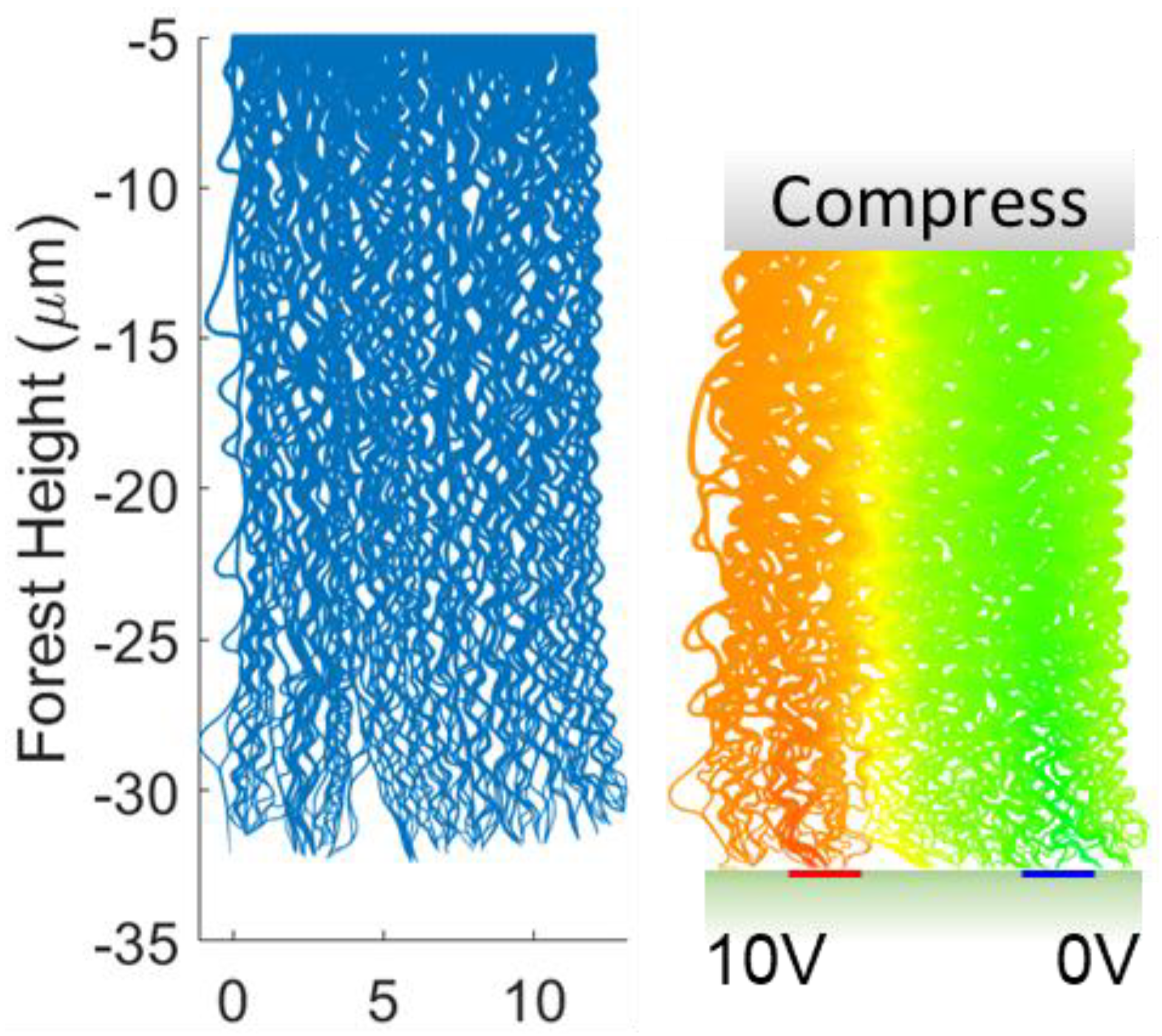
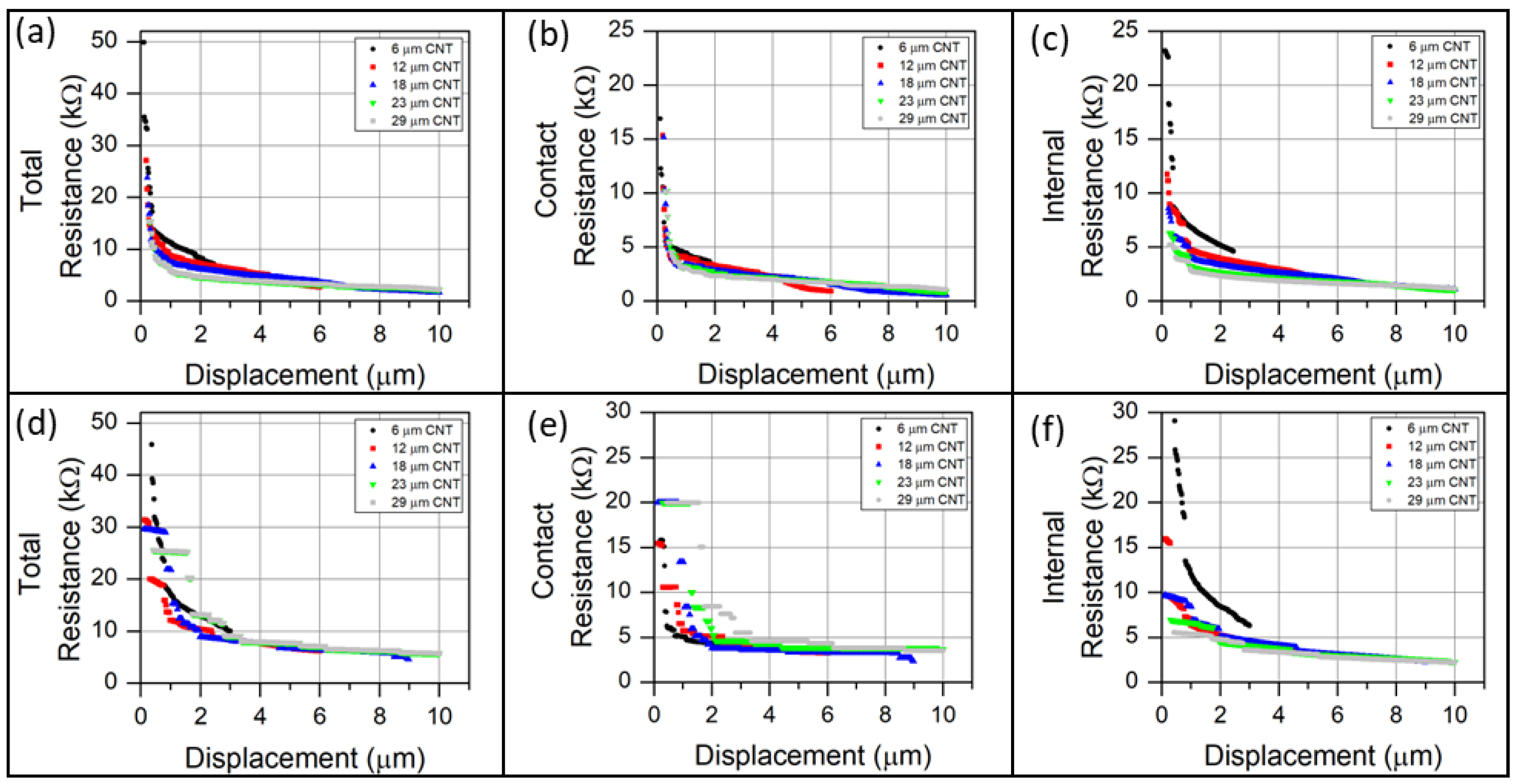

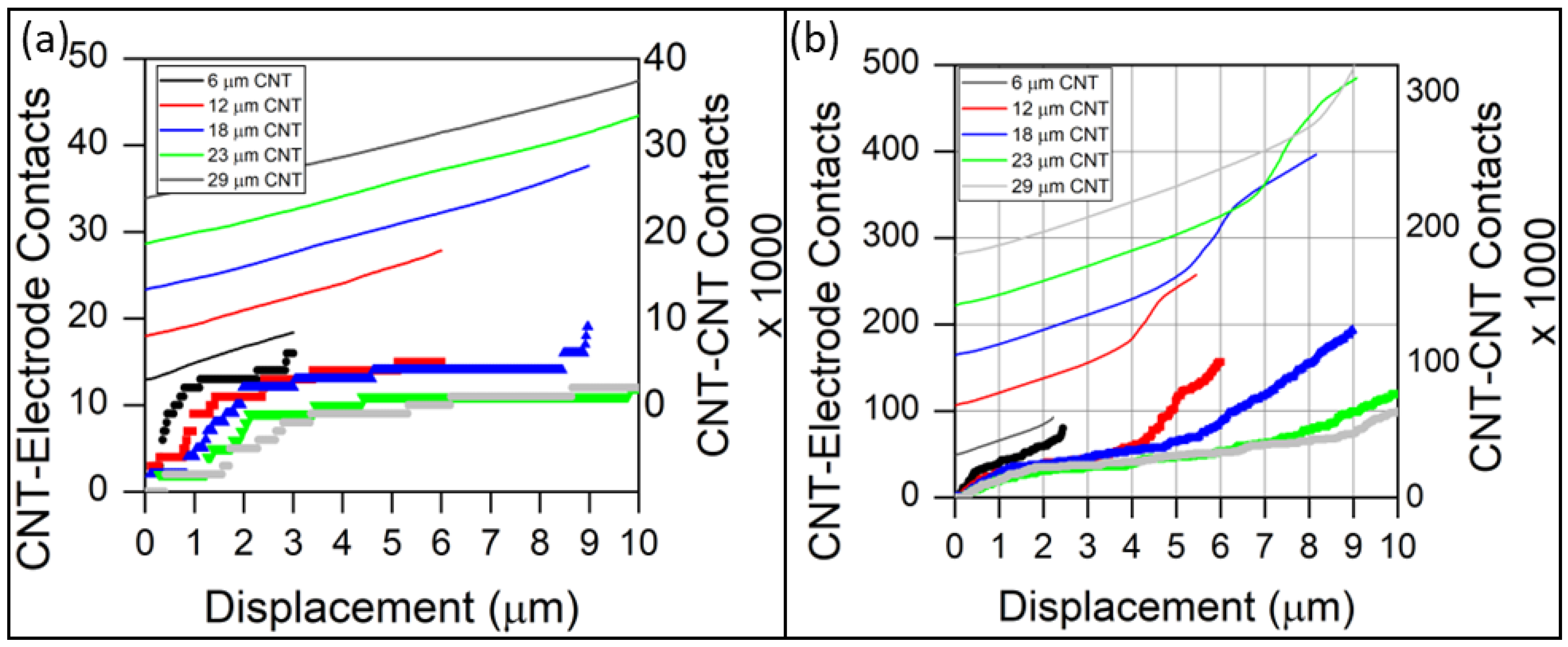
Disclaimer/Publisher’s Note: The statements, opinions and data contained in all publications are solely those of the individual author(s) and contributor(s) and not of MDPI and/or the editor(s). MDPI and/or the editor(s) disclaim responsibility for any injury to people or property resulting from any ideas, methods, instructions or products referred to in the content. |
© 2023 by the authors. Licensee MDPI, Basel, Switzerland. This article is an open access article distributed under the terms and conditions of the Creative Commons Attribution (CC BY) license (https://creativecommons.org/licenses/by/4.0/).
Share and Cite
Bellott, E.; Li, Y.; Gunter, C.; Kovaleski, S.; Maschmann, M.R. Investigating the Electromechanical Sensitivity of Carbon-Nanotube-Coated Microfibers. Sensors 2023, 23, 5190. https://doi.org/10.3390/s23115190
Bellott E, Li Y, Gunter C, Kovaleski S, Maschmann MR. Investigating the Electromechanical Sensitivity of Carbon-Nanotube-Coated Microfibers. Sensors. 2023; 23(11):5190. https://doi.org/10.3390/s23115190
Chicago/Turabian StyleBellott, Elizabeth, Yushan Li, Connor Gunter, Scott Kovaleski, and Matthew R. Maschmann. 2023. "Investigating the Electromechanical Sensitivity of Carbon-Nanotube-Coated Microfibers" Sensors 23, no. 11: 5190. https://doi.org/10.3390/s23115190
APA StyleBellott, E., Li, Y., Gunter, C., Kovaleski, S., & Maschmann, M. R. (2023). Investigating the Electromechanical Sensitivity of Carbon-Nanotube-Coated Microfibers. Sensors, 23(11), 5190. https://doi.org/10.3390/s23115190







